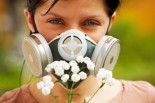There's a toxic epidemic going on, and it's affecting your food, water, air and many of the common items you use on an everyday basis.
Are you doomed to suffer with this toxic overload?
According to Dr. Mark R. Carney, there are a lot of common sense things you can do to ease exposure and even eliminate certain symptoms.
The first is to identify the source. You can detoxify all you want, but if you're constantly immersed in the source of the pollution, you're just participating in that never-ending cycle.
What are some of those sources?
Water is a major source for heavy metals, including cadmium, arsenic and lead. These chemicals affect both drinking water and the water supply that irrigates crops, which then gets into the soil and eventually your food.
The very structure of your home alone can contain endless toxins, from your carpet and furniture, to the cleaning products and personal care products you use.
And, of course, the pollution contained in the air can also be a culprit.
Some people are more sensitive to toxins, something Dr. Carney refers to as "environmental illness." These individuals are like the canaries in the coal mine... if they're reacting to it, we're ALL reacting to it; they're just manifesting the symptoms first.
Symptoms of toxic exposure can be very common: dizziness, fatigue, loss for words, brain fog. These initial symptoms can eventually lead to chronic fatigue, cancers, ADD/ADHD, asthma, and more.
How can you determine if you're at risk?
In Dr. Carney's opinion, sampling of fat tissue is the gold standard. But, not everyone is able to do that. Blood and urine samples are a great alternative, as they can test for dozens of toxins.
Once you've identified the source and reduced your level of exposure, then you can focus on detoxification.
Sweating is actually a very effective method for detoxing. Saunas and infrared saunas are most optimal. Sweating from exercising also helps, but the heat is what makes the big difference. Even just 5-10 minutes every other day in an infrared sauna can do wonders.
In fact, Dr. Carney says perspiration is a great clue. If you're someone who doesn't sweat much, even in hot conditions, you may have a significant toxic build-up.
The key to remember is that "genetics holds the gun, but environment pulls the trigger." You may be pre-disposed to certain diseases (or even to be more susceptible to things like mold), but it's your environment that triggers the actual effects. If you can control your environment, even just a little, you're already steps ahead.
In the accompanying audio segment, Dr. Carney joins host Lisa Davis to discuss the damaging effects of the toxins in our environment, and how you can reduce your exposure and eliminate the effects.

Health Topics A-Z
The Many Sources of Environmental Toxicity
Guest
: Mark Carney, ND, LAc
From the Show: Naturally Savvy
Summary: There's a toxic epidemic going on, and it's affecting your food, water, air and many of the common items you use on an everyday basis.
Air Date: 8/12/15
Duration: 10
Host: Andrea Donsky, RHN and Lisa Davis, MPH

Sylvia Anderson
Originally from Minnesota, Sylvia moved to California for the sun, sand and warm temperatures. She graduated from the University of Minnesota with a degree in English and Communications, both of which she has put to good use in her work with RadioMD as Senior Editor.
Her past work, including articles, editorials and blogs, has been published nationwide - online and in various print publications.
Sylvia truly believes in taking health seriously! From nutrition and physical fitness to alternative therapies, Sylvia credits her incredible wellness to living a healthy lifestyle. And, as one of the editors of RadioMD, she feels lucky to be able to learn something new about health each and every day.
Tagged under





